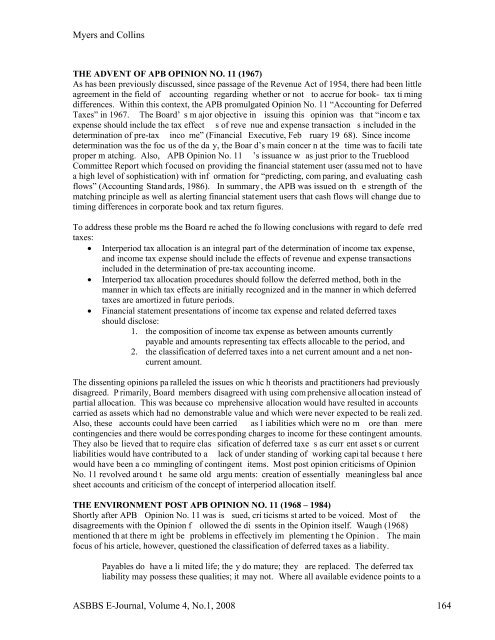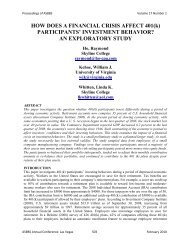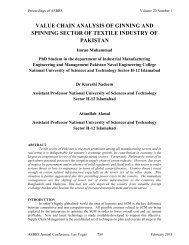stock repurchase announcements: a test of market ... - Asbbs.org
stock repurchase announcements: a test of market ... - Asbbs.org
stock repurchase announcements: a test of market ... - Asbbs.org
Create successful ePaper yourself
Turn your PDF publications into a flip-book with our unique Google optimized e-Paper software.
Myers and Collins<br />
THE ADVENT OF APB OPINION NO. 11 (1967)<br />
As has been previously discussed, since passage <strong>of</strong> the Revenue Act <strong>of</strong> 1954, there had been little<br />
agreement in the field <strong>of</strong> accounting regarding whether or not to accrue for book- tax ti ming<br />
differences. Within this context, the APB promulgated Opinion No. 11 “Accounting for Deferred<br />
Taxes” in 1967. The Board’ s m ajor objective in issuing this opinion was that “incom e tax<br />
expense should include the tax effect s <strong>of</strong> reve nue and expense transaction s included in the<br />
determination <strong>of</strong> pre-tax inco me” (Financial Executive, Feb ruary 19 68). Since income<br />
determination was the foc us <strong>of</strong> the da y, the Boar d’s main concer n at the time was to facili tate<br />
proper m atching. Also, APB Opinion No. 11 ’s issuance w as just prior to the Trueblood<br />
Committee Report which focused on providing the financial statement user (assumed not to have<br />
a high level <strong>of</strong> sophistication) with inf ormation for “predicting, com paring, and evaluating cash<br />
flows” (Accounting Standards, 1986). In summary, the APB was issued on th e strength <strong>of</strong> the<br />
matching principle as well as alerting financial statement users that cash flows will change due to<br />
timing differences in corporate book and tax return figures.<br />
To address these proble ms the Board re ached the fo llowing conclusions with regard to defe rred<br />
taxes:<br />
• Interperiod tax allocation is an integral part <strong>of</strong> the determination <strong>of</strong> income tax expense,<br />
and income tax expense should include the effects <strong>of</strong> revenue and expense transactions<br />
included in the determination <strong>of</strong> pre-tax accounting income.<br />
• Interperiod tax allocation procedures should follow the deferred method, both in the<br />
manner in which tax effects are initially recognized and in the manner in which deferred<br />
taxes are amortized in future periods.<br />
• Financial statement presentations <strong>of</strong> income tax expense and related deferred taxes<br />
should disclose:<br />
1. the composition <strong>of</strong> income tax expense as between amounts currently<br />
payable and amounts representing tax effects allocable to the period, and<br />
2. the classification <strong>of</strong> deferred taxes into a net current amount and a net noncurrent<br />
amount.<br />
The dissenting opinions pa ralleled the issues on whic h theorists and practitioners had previously<br />
disagreed. P rimarily, Board members disagreed with using com prehensive allocation instead <strong>of</strong><br />
partial allocation. This was because co mprehensive allocation would have resulted in accounts<br />
carried as assets which had no demonstrable value and which were never expected to be reali zed.<br />
Also, these accounts could have been carried as l iabilities which were no m ore than mere<br />
contingencies and there would be corres ponding charges to income for these contingent amounts.<br />
They also be lieved that to require clas sification <strong>of</strong> deferred taxe s as curr ent asset s or current<br />
liabilities would have contributed to a lack <strong>of</strong> under standing <strong>of</strong> working capi tal because t here<br />
would have been a co mmingling <strong>of</strong> contingent items. Most post opinion criticisms <strong>of</strong> Opinion<br />
No. 11 revolved around t he same old argu ments: creation <strong>of</strong> essentially meaningless bal ance<br />
sheet accounts and criticism <strong>of</strong> the concept <strong>of</strong> interperiod allocation itself.<br />
THE ENVIRONMENT POST APB OPINION NO. 11 (1968 – 1984)<br />
Shortly after APB Opinion No. 11 was is sued, cri ticisms st arted to be voiced. Most <strong>of</strong> the<br />
disagreements with the Opinion f ollowed the di ssents in the Opinion itself. Waugh (1968)<br />
mentioned th at there m ight be problems in effectively im plementing t he Opinion . The main<br />
focus <strong>of</strong> his article, however, questioned the classification <strong>of</strong> deferred taxes as a liability.<br />
Payables do have a li mited life; the y do mature; they are replaced. The deferred tax<br />
liability may possess these qualities; it may not. Where all available evidence points to a<br />
ASBBS E-Journal, Volume 4, No.1, 2008 164

















